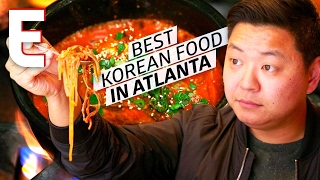Sunday, 04 January, 2026г.
















Где искать: по сайтам Запорожской области, статьи, видео ролики
пример: покупка автомобиля в Запорожье
Eating Korean Set Meal Stone Pot (Hanjeongsik 한정식 韓定食) on Valentine's Day in Korea
Today was Valentine's Day in Korea, so instead of stuffing ourselves with copious amounts of chocolate and candies, we decided to head out and eat a delicious Korean Set Meal (Stone Pot Set Lunch 한정식 韓定食) consisting of various types of Korean meats, Korean vegetables, Korean fish and Korean soups along with a plethora of savory side dishes for lunch near Audrey's Yongin apartment.
GEAR WE USE
Olympus OM-D E-M5 II: http://amzn.to/1OchS7t
Canon G7X: http://amzn.to/1YdjsYX
Olympus 14-150mm II Lens: http://amzn.to/1Y79zeM
Rode Video Mic GO: http://amzn.to/1WDKtVM
Joby Gorilla Pod: http://amzn.to/1PgoY5F
SanDisk 16GB Extreme Pro: http://amzn.to/25KEErs
SOCIAL MEDIA & TRAVEL BLOGS
AUDREY:
blog: http://thatbackpacker.com/
instagram: https://www.instagram.com/thatbackpacker/
facebook: https://www.facebook.com/thatbackpacker
twitter: https://twitter.com/ThatBackpacker
SAMUEL:
blog: http://nomadicsamuel.com/
facebook: https://www.facebook.com/nomadicsamuel
twitter: https://twitter.com/NomadicSamuel
instragram: https://www.instagram.com/nomadicsamuel/
I had very high expectations for this meal given how much I've enjoyed Korean set meals in the past; although, they're more expensive than typical budget friendly Korean types of options, they're literally feasts fit for kings and queens. With large portions, a plethora of main and side dishes and course after course being wielded out to your table, it's the type of meal you skip breakfast for in order to make room in your stomach for all of the food.
After waiting for a few minutes, the first part of the meal was brought to our table. It consisted of numerous meat dishes along with a number of our favorite Korean side dishes.
After devouring the first course we were starting to feel full; surprisingly the second course was even larger the the first replacing meat dishes with mostly fish based Korean samplers.
Overall, from the two courses, our favorite Korean dishes included Korean style jeon (also known as pizza), bulgogi (marinated beef strips) and japchae (sweet potato noodles mixed with vegetables).
We devoured everything feeling pleasantly full afterwards. Overall our meal was excellent value as we paid roughly $26 USD (26,000W) for the entire feast. Although this was a much more expensive meal than normal.
It was the perfect way to spend Valentine's Day in Korea and something we'll certainly remember:
http://nomadicsamuel.com/video-blog/stone-pot-korean-set-meal
Hanjeongsik is a full-course Korean meal with an array of savory side dishes. The most lavish of hanjeongsik traditional originated with the banquets served in the royal palaces or the homes of aristocrats. Usually the course starts with a cold appetizer and gruel, and the main dishes include dishes mixed with seasoning either grilled, boiled, steamed, fried, or salted. Hot pots are included as well, and after the meal traditional punches such as Sikhye(sweet rice punch) or Sujeonggwa(cinnamon-persimmon punch) and other desserts may be served. Actually the types or dishes served in the hanjeongsik vary significantly according to the season or region: http://www.koreafoods.co.uk/en/culture_02.php
Korean cuisine as a national cuisine known today has evolved through centuries of social and political change. Originating from ancient agricultural and nomadic traditions in southern Manchuria and the Korean peninsula, Korean cuisine has evolved through a complex interaction of the natural environment and different cultural trends.[2][3]
Korean cuisine is largely based upon rice, vegetables, and meats. Traditional Korean meals are noted for the number of side dishes (banchan) that accompany steam-cooked short-grain rice. Kimchi is served often, sometimes at every meal. Commonly used ingredients include sesame oil, doenjang (fermented bean paste), soy sauce, salt, garlic, ginger, pepper flakes and gochujang (fermented red chili paste).
Ingredients and dishes vary by province. Many regional dishes have become national, and dishes that were once regional have proliferated in different variations across the country. The Korean royal court cuisine once brought all of the unique regional specialties together for the royal family. Meals are regulated by Korean cultural etiquette
This is part of our Life in Korea series. We are two foreigners teaching English in Korea. As Waegook's (Korean for foreigners) we showcase Korea from the perspective of outsiders. As per usual, there is plenty of silly humor and bloopers at the end - signature moments of our travel videos.
Proudly presented by: http://nomadicsamuel.com , http://smilingfacestravelphotos.com , http://thatbackpacker.com & http://backpacking-travel-blog.com
All photos and video taken by Samuel Jeffery (Nomadic Samuel) and Audrey Bergner (That Backpacker).
This video features the song ''Opium - Kevin Macleod" available under a Creative Commons Attribution-Commercial license.
Теги:
Korean traditional food Korean Stone Pot Korea Korean cuisine 한정식 韓定食 Korean restaurant Korean meal Yongin restaurant restaurant in Korea Korean food Yongin restaurant in Yongin Hanjeongsik Korean Set Lunch stone pot meal in korea Korean Set Meal South Korea travel eating Korean food Life in Korea Cooking Korean food Preparing Korean food Living in Korea English Teachers in Korea Foreigners in Korea Valentine's Day in Korea Korean side dishes vlog fun
Похожие видео
Мой аккаунт


 У вашего броузера проблема в совместимости с HTML5
У вашего броузера проблема в совместимости с HTML5
![LOCAL KOREAN FOOD YOU MUST TRY IN SOUTH KOREA [HIRO GOES TO SOUTH KOREA - PART 2]](/images/mq/6/fb/9EVV0skQc1HBva.jpg)

![How To Learn Taekwondo [Korean Bros]](/images/mq/f/8e/8JKLLMEEd8_bm3.jpg)